11.3: Echinoderms
- Page ID
- 12259
\( \newcommand{\vecs}[1]{\overset { \scriptstyle \rightharpoonup} {\mathbf{#1}} } \)
\( \newcommand{\vecd}[1]{\overset{-\!-\!\rightharpoonup}{\vphantom{a}\smash {#1}}} \)
\( \newcommand{\dsum}{\displaystyle\sum\limits} \)
\( \newcommand{\dint}{\displaystyle\int\limits} \)
\( \newcommand{\dlim}{\displaystyle\lim\limits} \)
\( \newcommand{\id}{\mathrm{id}}\) \( \newcommand{\Span}{\mathrm{span}}\)
( \newcommand{\kernel}{\mathrm{null}\,}\) \( \newcommand{\range}{\mathrm{range}\,}\)
\( \newcommand{\RealPart}{\mathrm{Re}}\) \( \newcommand{\ImaginaryPart}{\mathrm{Im}}\)
\( \newcommand{\Argument}{\mathrm{Arg}}\) \( \newcommand{\norm}[1]{\| #1 \|}\)
\( \newcommand{\inner}[2]{\langle #1, #2 \rangle}\)
\( \newcommand{\Span}{\mathrm{span}}\)
\( \newcommand{\id}{\mathrm{id}}\)
\( \newcommand{\Span}{\mathrm{span}}\)
\( \newcommand{\kernel}{\mathrm{null}\,}\)
\( \newcommand{\range}{\mathrm{range}\,}\)
\( \newcommand{\RealPart}{\mathrm{Re}}\)
\( \newcommand{\ImaginaryPart}{\mathrm{Im}}\)
\( \newcommand{\Argument}{\mathrm{Arg}}\)
\( \newcommand{\norm}[1]{\| #1 \|}\)
\( \newcommand{\inner}[2]{\langle #1, #2 \rangle}\)
\( \newcommand{\Span}{\mathrm{span}}\) \( \newcommand{\AA}{\unicode[.8,0]{x212B}}\)
\( \newcommand{\vectorA}[1]{\vec{#1}} % arrow\)
\( \newcommand{\vectorAt}[1]{\vec{\text{#1}}} % arrow\)
\( \newcommand{\vectorB}[1]{\overset { \scriptstyle \rightharpoonup} {\mathbf{#1}} } \)
\( \newcommand{\vectorC}[1]{\textbf{#1}} \)
\( \newcommand{\vectorD}[1]{\overrightarrow{#1}} \)
\( \newcommand{\vectorDt}[1]{\overrightarrow{\text{#1}}} \)
\( \newcommand{\vectE}[1]{\overset{-\!-\!\rightharpoonup}{\vphantom{a}\smash{\mathbf {#1}}}} \)
\( \newcommand{\vecs}[1]{\overset { \scriptstyle \rightharpoonup} {\mathbf{#1}} } \)
\( \newcommand{\vecd}[1]{\overset{-\!-\!\rightharpoonup}{\vphantom{a}\smash {#1}}} \)
\(\newcommand{\avec}{\mathbf a}\) \(\newcommand{\bvec}{\mathbf b}\) \(\newcommand{\cvec}{\mathbf c}\) \(\newcommand{\dvec}{\mathbf d}\) \(\newcommand{\dtil}{\widetilde{\mathbf d}}\) \(\newcommand{\evec}{\mathbf e}\) \(\newcommand{\fvec}{\mathbf f}\) \(\newcommand{\nvec}{\mathbf n}\) \(\newcommand{\pvec}{\mathbf p}\) \(\newcommand{\qvec}{\mathbf q}\) \(\newcommand{\svec}{\mathbf s}\) \(\newcommand{\tvec}{\mathbf t}\) \(\newcommand{\uvec}{\mathbf u}\) \(\newcommand{\vvec}{\mathbf v}\) \(\newcommand{\wvec}{\mathbf w}\) \(\newcommand{\xvec}{\mathbf x}\) \(\newcommand{\yvec}{\mathbf y}\) \(\newcommand{\zvec}{\mathbf z}\) \(\newcommand{\rvec}{\mathbf r}\) \(\newcommand{\mvec}{\mathbf m}\) \(\newcommand{\zerovec}{\mathbf 0}\) \(\newcommand{\onevec}{\mathbf 1}\) \(\newcommand{\real}{\mathbb R}\) \(\newcommand{\twovec}[2]{\left[\begin{array}{r}#1 \\ #2 \end{array}\right]}\) \(\newcommand{\ctwovec}[2]{\left[\begin{array}{c}#1 \\ #2 \end{array}\right]}\) \(\newcommand{\threevec}[3]{\left[\begin{array}{r}#1 \\ #2 \\ #3 \end{array}\right]}\) \(\newcommand{\cthreevec}[3]{\left[\begin{array}{c}#1 \\ #2 \\ #3 \end{array}\right]}\) \(\newcommand{\fourvec}[4]{\left[\begin{array}{r}#1 \\ #2 \\ #3 \\ #4 \end{array}\right]}\) \(\newcommand{\cfourvec}[4]{\left[\begin{array}{c}#1 \\ #2 \\ #3 \\ #4 \end{array}\right]}\) \(\newcommand{\fivevec}[5]{\left[\begin{array}{r}#1 \\ #2 \\ #3 \\ #4 \\ #5 \\ \end{array}\right]}\) \(\newcommand{\cfivevec}[5]{\left[\begin{array}{c}#1 \\ #2 \\ #3 \\ #4 \\ #5 \\ \end{array}\right]}\) \(\newcommand{\mattwo}[4]{\left[\begin{array}{rr}#1 \amp #2 \\ #3 \amp #4 \\ \end{array}\right]}\) \(\newcommand{\laspan}[1]{\text{Span}\{#1\}}\) \(\newcommand{\bcal}{\cal B}\) \(\newcommand{\ccal}{\cal C}\) \(\newcommand{\scal}{\cal S}\) \(\newcommand{\wcal}{\cal W}\) \(\newcommand{\ecal}{\cal E}\) \(\newcommand{\coords}[2]{\left\{#1\right\}_{#2}}\) \(\newcommand{\gray}[1]{\color{gray}{#1}}\) \(\newcommand{\lgray}[1]{\color{lightgray}{#1}}\) \(\newcommand{\rank}{\operatorname{rank}}\) \(\newcommand{\row}{\text{Row}}\) \(\newcommand{\col}{\text{Col}}\) \(\renewcommand{\row}{\text{Row}}\) \(\newcommand{\nul}{\text{Nul}}\) \(\newcommand{\var}{\text{Var}}\) \(\newcommand{\corr}{\text{corr}}\) \(\newcommand{\len}[1]{\left|#1\right|}\) \(\newcommand{\bbar}{\overline{\bvec}}\) \(\newcommand{\bhat}{\widehat{\bvec}}\) \(\newcommand{\bperp}{\bvec^\perp}\) \(\newcommand{\xhat}{\widehat{\xvec}}\) \(\newcommand{\vhat}{\widehat{\vvec}}\) \(\newcommand{\uhat}{\widehat{\uvec}}\) \(\newcommand{\what}{\widehat{\wvec}}\) \(\newcommand{\Sighat}{\widehat{\Sigma}}\) \(\newcommand{\lt}{<}\) \(\newcommand{\gt}{>}\) \(\newcommand{\amp}{&}\) \(\definecolor{fillinmathshade}{gray}{0.9}\)
Believe it or not, this is an animal. See the mouth and arms?
It is a sea lily, a crinoid echinoderm. Crinoids are essentially a mouth on the top surface that is surrounded by feeding arms. Although the basic echinoderm pattern of fivefold symmetry can be recognized, most crinoids have many more than five arms. Crinoids usually have a stem used to attach themselves to a surface, but many become free-swimming as adults.
Echinoderms
Echinoderms are marine organisms that make up the phylum Echinodermata. They can be found in the ocean from the equator to the poles. There are roughly 6000 living species of echinoderms. They are among the most distinctive organisms within the animal kingdom. Members of the phylum include sea stars (starfish), sand dollars, and feather stars, shown in Figure below.
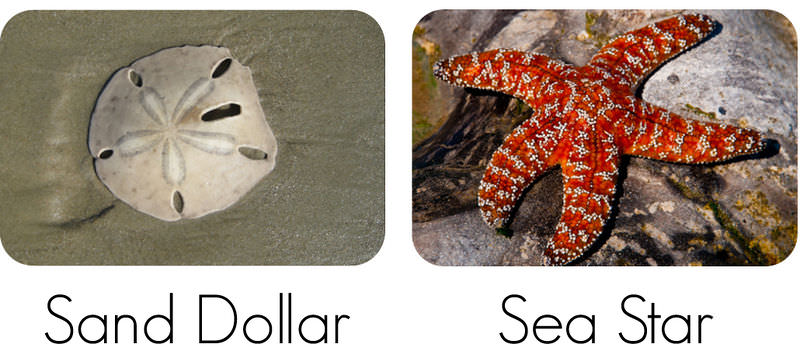 Examples of Echinoderms. You may have seen sea stars and sand dollars at the beach because they live in shallow water near the shore. Other echinoderms, such as feather stars, are less commonly seen because they live in the deep ocean.
Examples of Echinoderms. You may have seen sea stars and sand dollars at the beach because they live in shallow water near the shore. Other echinoderms, such as feather stars, are less commonly seen because they live in the deep ocean.Structure and Function of Echinoderms
Echinoderms are named for their “spiny skin.” However, the spines aren’t on their skin. They are part of the endoskeleton. The endoskeleton consists of calcium carbonate plates and spines, covered by a thin layer of skin. Adult echinoderms have radial symmetry. This is easy to see in the sea star and sand dollar in Figure above. However, echinoderms evolved from an ancestor with bilateral symmetry. Evidence for this is the bilateral symmetry of their larvae.
A unique feature of echinoderms is their water vascular system. This is a network of canals that extend along each body part. In most echinoderms, the canals have external projections called tube feet (see Figure below). The feet have suckers on the ends. Muscle contractions force water into the feet, causing them to extend outward. As the feet extend, they attach their suckers to new locations, farther away from their previous points of attachment. This results in a slow but powerful form of movement. The suckers are very strong. They can even be used to pry open the shells of prey.
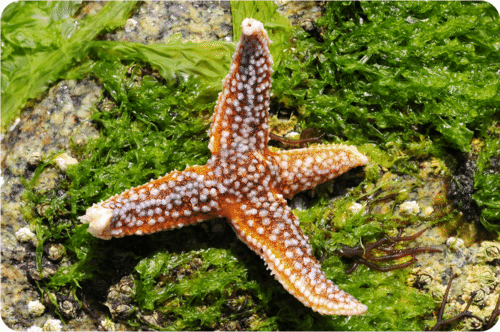 Tube Feet of a Sea Star. The tube feet of a sea star (in white) are part of its water vascular system. There is a sucker on the end of each foot that allows the animal to “walk” slowly over a surface. The suckers are strong enough to pry open shells.
Tube Feet of a Sea Star. The tube feet of a sea star (in white) are part of its water vascular system. There is a sucker on the end of each foot that allows the animal to “walk” slowly over a surface. The suckers are strong enough to pry open shells.Echinoderms lack respiratory and excretory systems. Instead, the thin walls of their tube feet allow oxygen to diffuse in and wastes to diffuse out. Echinoderms also lack a centralized nervous system. They have an open circulatory system and lack a heart. On the other hand, echinoderms have a well-developed coelom and a complete digestive system. Echinoderms use pheromones to communicate with each other. They detect the chemicals with sensory cells on their body surface. Some echinoderms also have simple eyes (ocelli) that can sense light. Like annelids, echinoderms have the ability to regenerate a missing body part.
Echinoderm Reproduction
Some echinoderms can reproduce asexually by fission, but most echinoderms reproduce sexually. They generally have separate sexes and external fertilization. Eggs hatch into free-swimming larvae. The larvae undergo metamorphosis to change into the adult form. During metamorphosis, their bilateral symmetry changes to radial symmetry.
Echinoderm Classification
Living echinoderms are placed in five classes. These five classes show many similarities. Organisms in each class are described in Table below.
| Class (includes) | Description | Example |
|---|---|---|
|
Crinoidea
|
fewer than 100 species; many have more than five arms; earliest and most primitive echinoderms; live on the ocean floor, mainly in deep water; filter feeders |
feather star 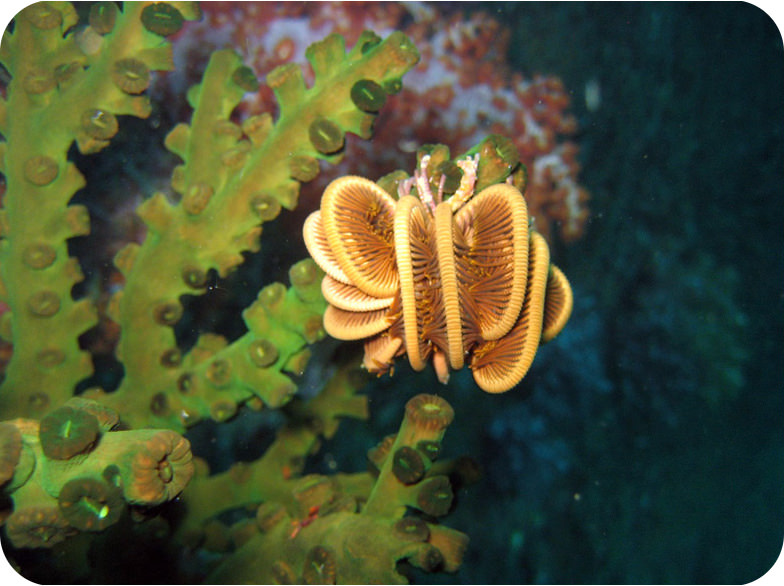 |
|
Asteroidea
|
almost 2000 species; most have five arms; many are brightly colored; live on the ocean floor, mainly in shallow water; predators or scavengers |
sea star  |
|
Ophiuroidea
|
about 2000 species; central disk distinct from arms; move by flapping their arms, which lack suckers; live on the ocean floor in shallow or deep water; predators, scavengers, deposit feeders, or filter feeders |
brittle star 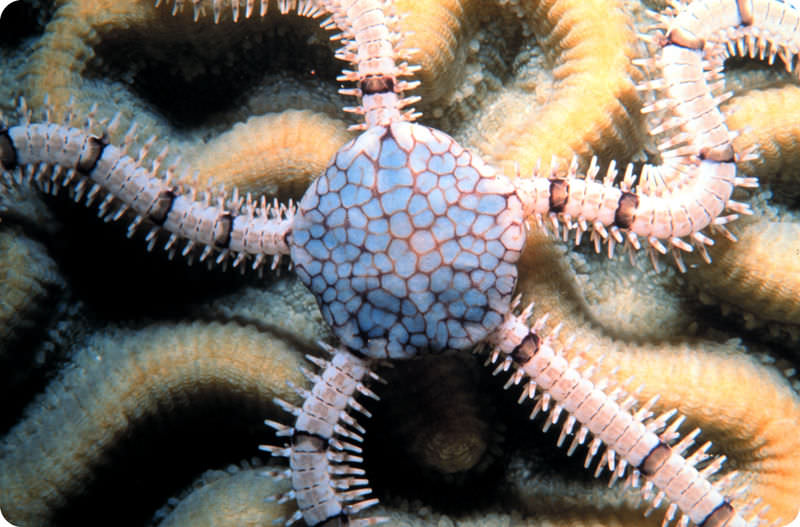 |
|
Echinoidea
|
about 100 species; do not have arms but do have tube feet; have a specialized mouth part with teeth to scrape food from rocks; live on the ocean floor in shallow or deep water; predators, herbivores, or filter feeders |
sea urchin 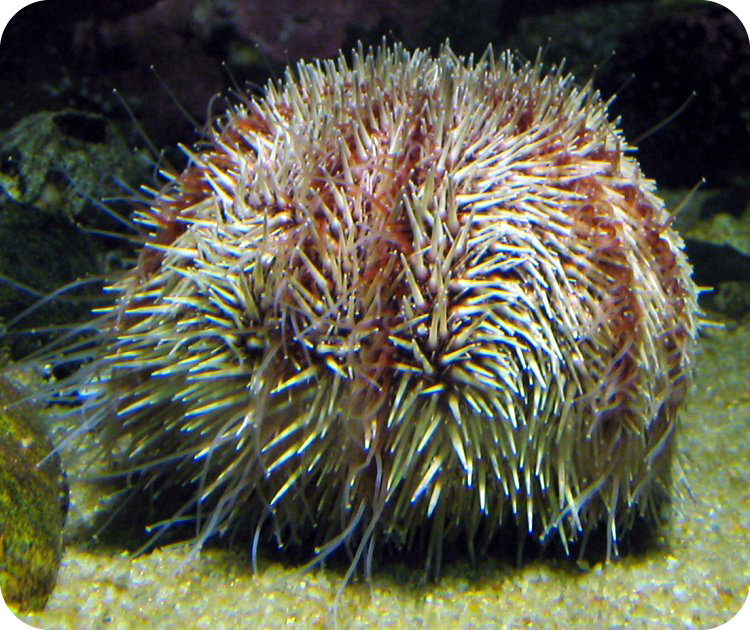 |
|
Holothuroidea
|
about 1000 species; long body without arms; unlike other echinoderms, have a respiratory system; live on the ocean floor in shallow or deep water; deposit feeders, or filter feeders |
sea cucumber 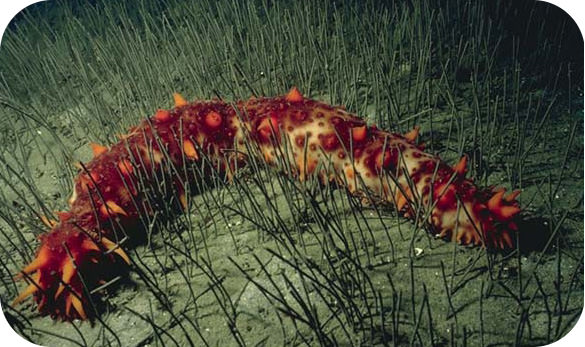 |
Summary
- Echinoderms are marine invertebrates. They include sea stars, sand dollars, and feather stars.
- Echinoderms have a spiny endoskeleton. They have radial symmetry as adults but bilateral symmetry as larvae.
- Echinoderms have a unique water vascular system with tube feet. This allows slow but powerful movement.
Review
- Describe the echinoderm endoskeleton.
- Give an example of an organism in each class of living echinoderms.
- Adult sea stars and other echinoderms have obvious radial symmetry. What evidence supports the claim that echinoderms evolved from an ancestor with bilateral symmetry?
- Explain the structure and function of the water vascular system.
| Image | Reference | Attributions |
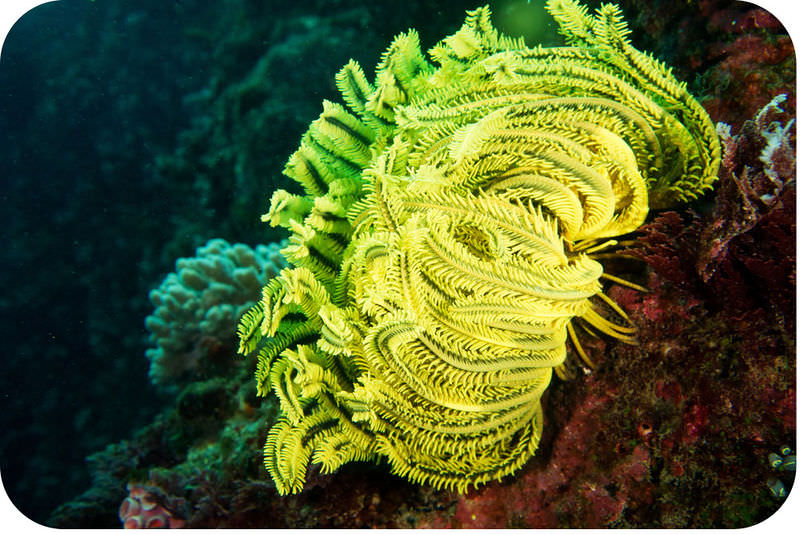 |
[Figure 1] | Credit: Image copyright Christian Musat, 2014 Source: http://www.shutterstock.com License: CC BY-NC |
 |
[Figure 2] | Credit: Sand dollar: Flickr:TheTurducken; Sea star: Ron Kroetz; Feather star: Courtesy of NOAA;By WYassineMrabetTalk✉This vector image was created with Inkscape. - Own work, CC BY-SA 3.0, commons.wikimedia.org/w/inde...?curid=8062105 Source: Sand dollar: http://www.flickr.com/photos/turducken/8881481190/ ; Sea star: http://www.flickr.com/photos/ronkroetz/7609957394/ ; Feather star: commons.wikimedia.org/wiki/File:Harpacticoid_copepod_GLERL_1.jpg ; By WYassineMrabetTalk✉This vector image was created with Inkscape. - Own work ; CC BY-SA 3.0 ; commons.wikimedia.org/w/index.php?curid=8062105 License: Sand dollar and Sea Star: CC BY 2.0; Feather Star: Public Domain |
 |
[Figure 3] | Credit: Image copyright Christian Musat, 2014 Source: http://www.shutterstock.com License: Used under license from Shutterstock.com |
 |
[Figure 4] | License: CC BY-NC |
 |
[Figure 5] | License: CC BY-NC |
 |
[Figure 6] | License: CC BY-NC |
 |
[Figure 7] | License: CC BY-NC |
 |
[Figure 8] | License: CC BY-NC |

